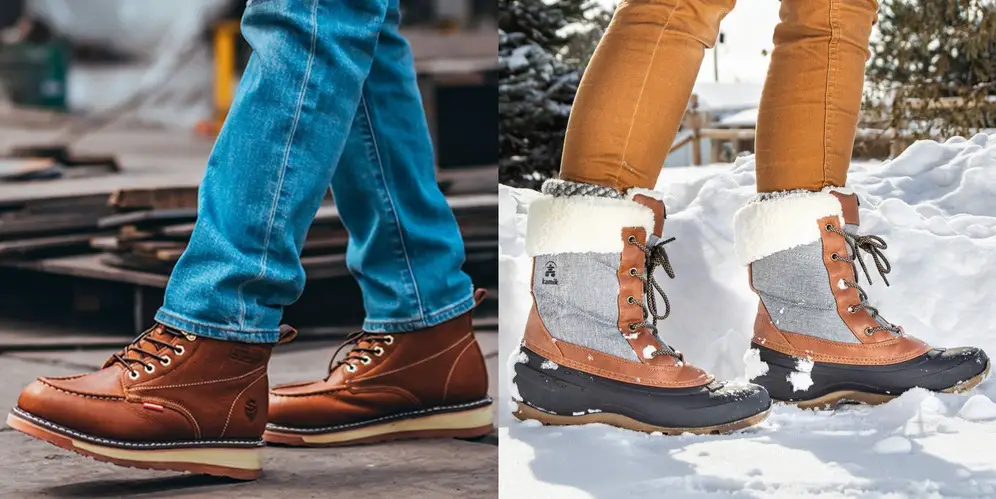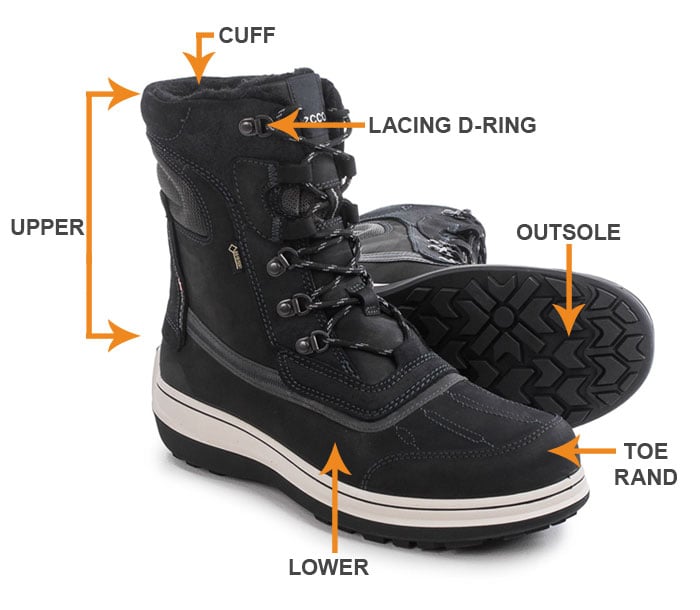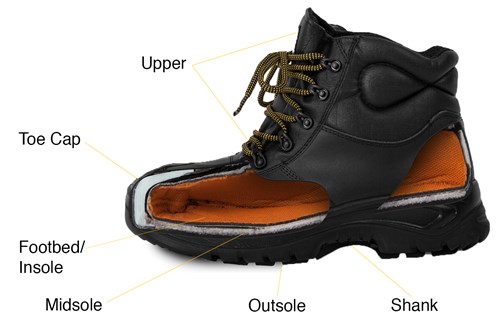Work boots and snow boots are the kind of footwear that protects our feet from harsh external conditions. Today we’ll look into the details of both the footwears.
A work boot is an essential piece of PPE in any trade where physical labor is involved or there are risks involved, whereas a snow boot is made of waterproof and insulating materials that keeps your feet dry and warm in the freezing temperatures of snow.

Work Boot Vs Snow Boot
1.) Construction
The first difference between work boots and snow boots is the way they are made. Let us look at each of them.
Construction of Snow boots
Upper Framework- The upper part of the snow boot begins with sealed seams, which serve as a moisture barrier and this area of the boot is typically reinforced with a polyurethane fiber that also serves as padding to cushion your ankles and shins, and also to prevent snow from seeping into the boot.
Fabrics are typically made of textile, leather, nylon, suede, or a combination of these water-resistant materials.
Midsole- The majority of the technical and supportive features of snow boots are found in the midsole construction.
Supportive shanks are a popular addition to the midsole, designed to protect your shins’ vertical bearing.

Inner framework- You should carefully observe the inner framework of snow boot because the lining is essential for insulation and thermal control. The main materials used for snow boot lining are fleece, microfleece, faux fur, textile, and waterproof membrane.
Soles- The sole is the primary component of the snow boot that keeps you safe. The desired sole is thick and rugged, and rubber is almost always the best choice due to its durability, lightweight consistency, and waterproof nature. The outsole is frequently made of RPT and PVC.
Snow boots, as opposed to walking or hiking boots, have a softer, more flexible sole that provides more traction on ice. The sole’s groove shape and depth are intended to withstand varying levels of terrain roughness.
Construction of work boots
Certain features are required when purchasing work boots to ensure that the footwear you choose is appropriate for your environment.
Upper- The upper is the portion of a boot that covers the toes, top of the foot, sides of the foot, and back of the heel. It can be made of a single piece or a number of different pieces stitched together, depending on the style of the boot. The vamp, back, tongue, quarter, and lining are all examples of uppers.
Uppers can be made of a variety of materials, but leather has been the most popular.
Foot rest- The foot bed, also known as the insole, is the inside part of the boot that runs under the foot’s bottom. The footbed of a boot improves wearer comfort, which helps to increase satisfaction and efficiency at work.

Safety toe cap- Safety toe caps are reinforcement caps placed beneath the upper in the toe area to protect the foot from falling objects or compression. Steel has traditionally been used for toe caps, but in recent years, many safety boots have a composite toe cap.
Shank- The shank is a supportive structure that runs underneath the arch of the foot and sits between the boot’s insole and outsole.
The rigidity and stability of work boots are provided by the support structure. Steel, plastic, fiberglass, and kevlar are all possible materials for the shank. They make the outsole stiffer to provide a more stable fit.
Midsole- The midsole, which sits between the foot bed and the outside, absorbs shock and provides support to the wearer.
Midsoles can be made of a variety of materials, including polyurethane (PU), composite materials, Kevlar, and steel. To provide additional protection, midsoles can be made abrasion and cut resistant.
Outsole- The part of a shoe that makes direct contact with the ground. The outsole can be made of various materials such as leather, rubber, polyurethane, and TPU.
The outsole is an important component of work boots because it provides stability, traction, and protection from on-site slips and falls. They may also have additional properties such as heat and cold insulation.
2.) Insulation
All you desire for are warm and toasty feet when you are working in snowy conditions. You need to understand that the level of insulation of work boots depends on the type of boot you choose.
Even your work boots can provide enough insulation to keep you toasty during cold, but when it comes to snow boots, they are all well-insulated and provide plenty of warmth.
3.) Ankle support
The difference between work boots and snow boots is the amount of ankle support that each boot provides.
Because of the harsh terrain during snow, a pair of snow boots will provide better ankle support for you to walk smoothly without any hassle, though it will make them bulkier and a little heavier as a result.
However, all work boots do not come with ankle support.
4.) Traction
Snow boots of course need good traction to keep people safe from slipping in the snow. They are designed to keep you upright while you’re walking or working in snow, so you can count on them to provide solid grip.
However, work boots also provide good traction depending on the type of work and environment you put them in. As long as you get a good pair of winter-specific work boots, you should have plenty of traction.
5.) Waterproof
Your snow boots need to be absolutely waterproof for it to be employed during snow. It is because when you’re working in snow, there is a good chance the snow and moisture will seep in through the boots which is extremely uncomfortable and dangerous.
Most work boots are not waterproof, however they are water- resistant. But they can be made waterproof by external efforts.
6.) Breathability
When it comes to breathability, snow boots are at a disadvantage because in order to be waterproof, they have to compromise on breathability. However, work boots are comparatively more breathable as they are constructed of leather and will let your feet breathe.
7.) Weight
Work boots are sturdy and heavy, but not too heavy because, at the end of the day, they are still work boots and should be easy to walk around in. While you shouldn’t expect your work boot to be light, it is lighter than snow boots.
Work boots come in a variety of weights, but they are generally lighter than snow boots.
Snow boots are bulky and heavy because of extra features embedded in them for safety and insulation purposes.
8.) Comfort
Comfort is a major consideration when travelling long distances in the cold. Work boots are extremely comfortable once you are over the break in period. Snow boots, on the other hand, are heavy, bulky, and not very breathable.
9.) Versatility
Work boots are more versatile than snow boots because you can employ them year long irrespective of the weather and season.
However, snow boots are not very versatile because you cannot use them year long. It is just made for one purpose- to keep your feet warm and safe during snow.
Therefore, work boots are probably the most cost-effective option if you only want to make one purchase.
Work Boot and Snow Boot Comparison Table
| Features | Work boot | Snow boots |
| Ankle support | No | Yes |
| Weight | Heavy | Heavier than work boots |
| Height | Comes in various heights. | Comparatively longer than work boots. |
| Traction | Good | Excellent |
| Waterproof | Yes, but not all models. | Yes |
| Breathable | Yes | No |
| Insulation | Yes, but not all models. | Yes |
| Comfort | Yes | No |
| Soles | Rubber, PU, leather | Heavy duty rubber |
| Versatility | Yes | No |
FAQs-
Can you wear work boots in snow?
Although work boots are comfortable and lighter when compared to snow boots, it is not a good idea to wear work boots during snow because of various reasons-
First, since it is not designed to be worn during snow, it does not have enough insulation to keep your feet toasty and warm.
Second, snow boots are waterproof enough to keep snow and moisture away from your feet. However, a regular pair of work boots might not be able to defend your feet against snow for a long time.
Should you wear snow boots regularly?
No, snow boots are not advisable to use for regular use as they are heavy, unbreathable and seem impractical when there is no snow. It should only be worn during snow as it has been designed to keep your feet protected in extreme cold.
Work Boots Vs Snow Boots- What do we prefer?
Well it is entirely up to the type of work and environment that decides if you need work boots or snow boots.
Work boots provide flexible and solid heavy-duty protection, whereas snow boots focus on keeping your feet dry and warm in cold, wet weather.
Because while working in snow, you need a good pair of snow boots to help you sustain in the extreme condition.
Work boots work fine if you have a job on a construction site or in a warehouse where the weather is drier and warmer.
Conclusion
Well, both work boots and snow boots have their set of advantages and disadvantages. However, work boots offer more versatility and comfort as compared to snow boots that are only suited for extreme cold regions.
Look into the kind of work you’re doing, and the environment before you decide between the two.







